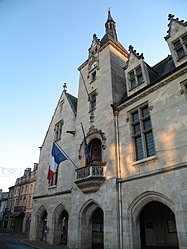Libourne
Subprefecture and commune in Nouvelle-Aquitaine, France From Wikipedia, the free encyclopedia
Subprefecture and commune in Nouvelle-Aquitaine, France From Wikipedia, the free encyclopedia
Libourne (French pronunciation: [libuʁn] ; Gascon: Liborna [liˈbuɾnɔ]) is a commune in the Gironde department in Nouvelle-Aquitaine in southwestern France. It is a sub-prefecture of the department.
Libourne | |
|---|---|
Subprefecture and commune | |
 Town hall | |
| Coordinates: 44°55′N 0°14′W | |
| Country | France |
| Region | Nouvelle-Aquitaine |
| Department | Gironde |
| Arrondissement | Libourne |
| Canton | Le Libournais-Fronsadais |
| Intercommunality | CA Libournais |
| Government | |
| • Mayor (2020–2026) | Philippe Buisson[1] (PS) |
| Area 1 | 20.63 km2 (7.97 sq mi) |
| Population (2021)[2] | 24,557 |
| • Density | 1,200/km2 (3,100/sq mi) |
| Time zone | UTC+01:00 (CET) |
| • Summer (DST) | UTC+02:00 (CEST) |
| INSEE/Postal code | 33243 /33500 |
| Elevation | 2–28 m (6.6–91.9 ft) (avg. 15 m or 49 ft) |
| 1 French Land Register data, which excludes lakes, ponds, glaciers > 1 km2 (0.386 sq mi or 247 acres) and river estuaries. | |
It is the wine-making capital of northern Gironde and lies near Saint-Émilion and Pomerol.

Libourne is located at the confluence of the Isle and Dordogne rivers. Libourne station has rail connections to Bordeaux, Bergerac, Angoulême, Périgueux, Limoges, Brive-la-Gaillarde and Sarlat-la-Canéda.
In 1270, Leybornia was founded as a bastide by Roger de Leybourne (of Leybourne, Kent), an English seneschal of Gascony, under the authority of King Edward I of England. It suffered considerably in the struggles of the French and English for the possession of Gironde in the 14th century, and joined France in the 15th century.

In December 1854 John Stuart Mill passed through Libourne, remarking "I stopped at Libourne as I intended & had a walk about it this morning quite the best thing there is the bridge of the Dordogne, the view from which is really fine".[3]
|
| ||||||||||||||||||||||||||||||||||||||||||||||||||||||||||||||||||||||||||||||||||||||||||||||||||||||||||||||||||
| |||||||||||||||||||||||||||||||||||||||||||||||||||||||||||||||||||||||||||||||||||||||||||||||||||||||||||||||||||
| Source: EHESS[4] and INSEE (1968-2017)[5] | |||||||||||||||||||||||||||||||||||||||||||||||||||||||||||||||||||||||||||||||||||||||||||||||||||||||||||||||||||
The Gothic church, restored in the 19th century, has a stone spire 232 ft (71 m) high. On the quay there is a machicolated clock-tower which is a survival of the defensive walls of the 14th century. The town-house, containing a small museum and a library, is a quaint relic of the 16th century. It is located by the main square, the Place Abel Surchamp, which hosts every weekend one of the largest fresh food market in the region. There is a statue of Élie, duc Decazes, who was born in the region.
Seamless Wikipedia browsing. On steroids.
Every time you click a link to Wikipedia, Wiktionary or Wikiquote in your browser's search results, it will show the modern Wikiwand interface.
Wikiwand extension is a five stars, simple, with minimum permission required to keep your browsing private, safe and transparent.